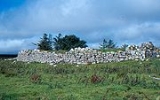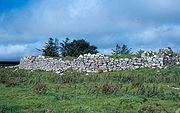
O'Davoren
Encyclopedia

Thomond
Thomond The region of Ireland associated with the name Thomond is County Clare, County Limerick and north County Tipperary; effectively most of north Munster. The name is used by a variety of establishments and organisations located in , or associated with the region...
(modern-day County Clare
County Clare
-History:There was a Neolithic civilisation in the Clare area — the name of the peoples is unknown, but the Prehistoric peoples left evidence behind in the form of ancient dolmen; single-chamber megalithic tombs, usually consisting of three or more upright stones...
), Ireland
Ireland
Ireland is an island to the northwest of continental Europe. It is the third-largest island in Europe and the twentieth-largest island on Earth...
active since medieval times.
Famed for their sponsorship of schools and knowledge of history and Early Irish law, the Ó Duibh dá Bhoireann's were known throughout Ireland as a literary family and held estates in the Burren
Burren
Burren can refer to:*The Burren, a karst landscape in County Clare, Ireland*Burren, County Down, a village in Northern Ireland*Burren College of Art, an art college in Ballyvaughan, County Clare, Ireland*Burrén and Burrena, twin hills in Aragon, Spain...
down to the mid seventeenth century at the time of the Cromwellian confiscations.http://www.ria.ie/committees/pdfs/archaeology/excavation_reports/odavoren-landscape.pdf. Many acted as brehon
Brehon
Brehon is the term in Gaelic-Irish culture for a judge. The Brehons were part of the system of "Brehon Law". The Brehons wore yellow robes when delivering verdicts. Several dozen families were recognised as hereditary brehon clans.-See also:* Mac an Bhaird...
s for the local ruling dynasty of Ó Loughlin from the 14th century or earlier.
The Ó Duibh dá Bhoireann law school at Cahermacnaghten has been the subject of archaeological and historical interest and its remains are still extant. The law school operated in the sixteenth and seventeenth century, with a Giolla na Naomh Óg Ó Duibh dá Bhoireann being recorded as one of its chief owners in the seventeenth century. The Ó Duibh dá Bhoireann's were recorded as still holding Cahermacnaghten in 1659, along with 13 Irish tenants. http://www.clarelibrary.ie/eolas/coclare/genealogy/pender/burren/bur4_nohovall.htm
Early Origins
The Ó Duibh dá Bhoireann's, like the O'Hehirs and some other septs west of the Shannon in County ClareCounty Clare
-History:There was a Neolithic civilisation in the Clare area — the name of the peoples is unknown, but the Prehistoric peoples left evidence behind in the form of ancient dolmen; single-chamber megalithic tombs, usually consisting of three or more upright stones...
Ireland
Ireland
Ireland is an island to the northwest of continental Europe. It is the third-largest island in Europe and the twentieth-largest island on Earth...
, belonged to the Eoghanacht stock claiming name and descent from the son of Aengus
Aengus
In Irish mythology, Óengus , Áengus , or Aengus or Aonghus , is a member of the Tuatha Dé Danann and probably a god of love, youth and poetic inspiration...
, King of Cashel, slain 957. The family settled in Burren in mediaeval times, exact date unknown. We first hear of them as hereditary ollamhs to the O'Loghlens of that district, who are of the race of Fergus mac Roigh, of Ulster. The earliest reference to them in print is in the Annals of the Four Masters under the year 1364, where the death of Giolla na Naomh Ó Duibh dá Bhoireann, ollamh of Corcomdhruadh in Brehon law, is recorded.
Literary Production
The most important surviving document associated with them is known as Egerton 88Egerton 88
MS Egerton 88 is a late sixteenth-century Irish manuscript, now housed in the British Library Egerton Collection, London. It is the work of members of the O'Davorens , a distinguished family of lawyers in Corcomroe, Co...
(British Library), being compiled between 1564 and 1569. It contains copies of some important texts of Early Irish law, in addition to a number of Old Irish literary tales.
External links
- Síaburcharpat Conculaind (The Phantom Chariot of CúchulainnCúchulainnCú Chulainn or Cúchulainn , and sometimes known in English as Cuhullin , is an Irish mythological hero who appears in the stories of the Ulster Cycle, as well as in Scottish and Manx folklore...
) from Egerton 88 at CELT

